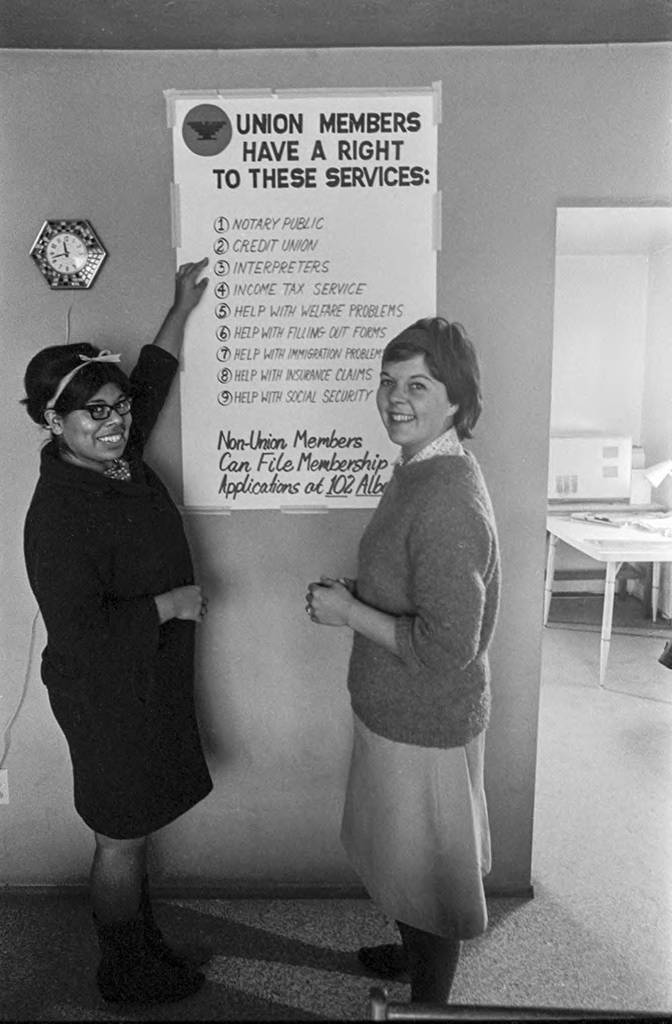Jessica Govea
Jessica Govea
Marshall Ganz and Jessica Govea speaking at a meeting, Lamont, ca. 1967. Photo by Emmon Clarke.
María de Jesús “Jessica” Govea (1947-2005) was born in Porterville, California. Her mother, Margarita de la Rosa, worked with her family in the cotton fields, vineyards, and orange groves. Her father migrated from Mexico during the bracero program. Her family moved to the barrio in Bakersfield called “Little Oakie” and she started picking cotton at age 4. In the summers, she worked with her mother picking cotton, grapes, onions, potatoes, and prunes until she was 15.
When she entered kindergarten at 5, school officials changed her name to “Jessica” because “María de Jesús” was too difficult to pronounce. Jessica excelled at school while working summers in the fields. Recruited by Fred Ross, her parents were co-founders of the Bakersfield chapter of the Community Service Organization (CSO). Since her early teens, she got interested in community activism and was a member and officer of the junior CSO. The student auxiliary of the CSO participated in fundraising, office work, and leafleting activities.
Jessica Govea sitting at her office at the National Farm Workers Association (NFWA) Service Center, Delano, 1967. Photo by Emmon Clarke.
Jessica Govea and Bonnie Chatfield standing next to the NFWA’s Service Center poster, Delano, 1967
Jerry Cohen recalls the impact Govea had on the issue of pesticides and health. “I met Jessica when she was nineteen while she was working in the Farm Worker Service Center. On one crucial day in the history of the union she brought to our attention three farm worker women who were suffering from severe rashes, nausea, dizziness, and double vision. The grower and the foreman said they were merely suffering from mild heat exhaustion. Jessica, remembering her own experience working in the fields, insisted that they were suffering from exposure to pesticides. Shortly after this, she came to work for me in the legal department and more than once asked what we could do about farm worker exposure to pesticides.” Later, Cohen found a way to work with environmentalist activists, whose campaign focused entirely on DDT’s threat to the environment and consumers instead of its effect on farmworkers. According to Frank Bardecke, “When UFWOC (United Farm Workers Organizing Committee) established that DDT and other powerful chlorinated hydrocarbons were used on table grapes, its battle to protect the health of farm workers became a central focus of the national anti-DDT, antipesticide campaign. Consumers could now boycott A&P and Safeway not only to help poor farm workers but also to avoid poisoning their own families.”
At 19, after quitting college, she decided to join the National Farm Workers Association (NFWA). She worked in different areas. First, she assisted Leroy Chatfield, who managed the Farm Worker Service Center. Six months later, she was transferred to work with Jerry Cohen in the legal department. Later, she was recruited by Dolores Huerta in the negotiations department.
Sam Kushner interviewing Jessica Govea and Bonnie Chatfield, Delano, 1967. Photo by Emmon Clarke.
In 1968, she, Marshall Ganz, and the Catholic priest Mark Day organized the grape boycott in Toronto, Canada. At 22, in 1969, she was sent to Montreal (the fourth largest grape-consuming city in North America) where she pressured Canadian consumers, gained the support of religious groups and public officials, recruited bilingual organizers, developed a door-to-door campaign, established picket lines, and even organized theater troupe to perform skits for picketers. When she returned to California, she became an international coordinator for the United Farm Workers (UFW) lettuce boycott. She was later back to Canada, in Toronto, to run the Gallo boycott from 1973 to 1975. In 1977 she was elected to the UFW executive board but left the union in 1981.
Tom & Ethel Bradley Center
California State University, Northridge
18111 Nordhoff Street, Northridge, CA 91330
Phone: (818) 677-1200 / Contact Us


